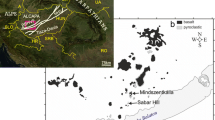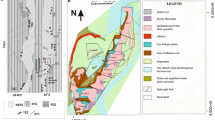Abstract
Granulite xenoliths within alkali olivine basalts of the Pali-Aike volcanic field, southern Chile, contain the mineral assemblage orthopyroxene + clinopyroxene + plagioclase + olivine + green spinel. These granulites are thought to be accidental inclusions of the lower crust incorporated in the mantle-derived basalt during its rise to the surface. Symplectic intergrowths of pyroxene and spinel developed between olivine and plagioclase imply that the reaction olivine+plagioclase = Al-orthopyroxene + Al-clinopyroxene + spinel (1) occurred during subsolidus cooling and recrystallization of a gabbroic protolith of the granulites.
Examination of fluid inclusions in the granulites indicates the ubiquitous presence of an essentially pure CO2 fluid phase. Inclusions of three different parageneses have been recognized: Type I inclusions occur along exsolution lamellae in clinopyroxene and are thought to represent precipitation of structurally-bound C or CO2 during cooling of the gabbro. These are considered the most primary inclusions present. Type II inclusions occur as evenly distributed clusters not associated with any fractures. These inclusions probably represent entrapment of a free fluid phase during recrystallization of the host grains. IIa inclusions are found in granoblastic grains and have densities of 0.68–0.88 g/cm3. Higher density (ϱ=0.90–1.02 g/cm3) IIb inclusions occur only in symplectite phases. Secondary Type III CO2+glass inclusions with ϱ=0.47–0.78 g/cm3 occur along healed fractures where basalt has penetrated the xenoliths. Type III inclusions appear related to exsolution of CO2 from the host basalt during its ascent to the surface. These data suggest that CO2 is an important constituent of the lower crust under conditions of granulite facies metamorphism, indicated by Type I and II fluid inclusions, and of the mantle, as indicated by Type III inclusions.
Correlation of fluid inclusion densities with P-T conditions calculated from both two-pyroxene geothermometry and reation (1) indicate emplacement of a gabbroic pluton at 1,200–1,300° C, 4–6 kb; cooling was accompanied by a slight increase in pressure due to crustal thickening, and symplectite formation occurred at 850±35° C, 5–7 kb. Capture of the xenoliths by the basalt resulted in heating of the granulites, and CO2 from the basalt was continuously entrapped by the xenoliths over the range 1,000–1,200° C, 4–6 kb. Examination of fluid inclusions of different generations can thus be used in conjunction with other petrologic data to place tight constraints on the specific P-T path followed by the granulite suite, in addition to indicating the nature of the fluid phase present at depth.
Similar content being viewed by others
References
Arculus RJ, Delano JW (1980) Implications for the primitive atmosphere of the oxidation state of Earth's upper mantle. Nature 288:72–74
Bilal A, Touret J (1976) Les inclusions fluides des enclaves catazonales de Bournac (Massif Central). Bull Soc Fr Mineral Cirstallogr 99:134–139
Bruhn RL, Stern CR, DeWit MJ (1978) Field and geochemical data bearing on the development of a Meszoic volcano-tectonic rift zone and back-arc basin in southernmost South America. Earth Planet Sci Lett 41:32–46
Burnham CW, Holloway JR, Davis NF (1969) Thermodynamic properties of water to 1,000° C and 10,000 bars. Geol Soc Amer Spec Pap 132:96 p
Buseck PR, Nord GL, Veblen DR (1980) Subsolidus phenomena in pyroxenes. CT Prewitt (eded) Pyroxenes. Mineral Soc Am Rev Mineral 7:117–211
Cunningham CG, Carollo C (1980) Modification of a fluid-inclusion heating/freezing stage. Econ Geol 75:335–338
Dostal J, Dupuy C, Leyreloup A (1980) Geochemistry and petrology of meta-igneous granulitic xenoliths in Neogene volcanic rocks of the Massif Central, France — implications for the lower crust. Earth Planet Sci Lett 50:31–40
Eggler DH (1975) CO2 as a volatile component of the mantle: the system Mg2SiO4-SiO2-H2O-CO2. Phys Chem Earth 9:869–881
Eggler DH, McCallum ME (1974) Xenoliths in diatremes of the western United States. Carnegie Inst Washington Yearb 73:294–300
Ehrenberg SN, Griffin WL (1979) Garnet granulite and associated xenoliths in minette and serpentinite diatremes of the Colorado Plateau. Geology 7:483–487
England RN, Corona structures formed by near-isochemical reaction between olivine and plagioclase in a metamorphosed dolerite. Mineral Mag 39:816–818
Francis DM (1976) Corona-bearing pyroxene granulite xenoliths and the lower crust beneath Nunivak Island, Alaska. Can Mineral 14:291–298
Freund F, Kathrein H, Wengeler H, Knobel R, Heinen HJ (1980) Carbon in solid solution in forsterite — a key to the untractable nature of reduced carbon in terrestrial and cosmogenic rocks. Geochim Cosmochim Acta 44:1319–1333
Gardner PM, Robins B (1974) The olivine-plagioclase reaction: geological evidence from the Seiland petrographie province, northern Norway. Contrib Mineral Petrol 44:149–156
Gooley R, Brett R, Warner J, Smyth JR (1974) A lunar rock of deep crustal origin: sample 76535. Geochim Cosmochim Acta 38:1329–1339
Green HW, Radcliffe SV (1975) Fluid precipitates in rocks from the earth's mantle. Geol Soc Amer Bull 86:846–852
Green DH, Ringwood AE (1967) An experimental investigation of the gabbro to eclogite transformation and its petrological applications. Geochim Cosmochim Acta 31:767–883
Green DH, Ringwood AE (1972) A comparison of recent experimental data on the gabbro-garnet granulite-eclogite transition. J Geol 80:277–288
Griffin WL (1971) Mineral reactions at a peridotite-gneiss contact, Jotunheimen, Norway. Mineral Mag 38:435–445
Griffin WL, Carswell DA, Nixon PH (1979) Lower-crustal granulites and eclogues from Lesotho, southern Africa. In: Boyd FR, Meyer HOA (eds) The mantle sample: inclusions in kimberlites and other volcanics (Proceedings 2nd Int Kimberlite Conf vol 2) Wash DC. AGU pp 59–86
Guilhaumou N, Dhameuncourt P, Touray JC, Barbillat J (1978) Analyse a la microsonde a effet Raman d'inclusions gazeuses du systeme N2-CO2. CR Acad Sci Paris 287:1317–1319
Halpern M (1973) Regional geochronology of Chile south of 50° latitude. Geol Soc Am, Bull 84:2407–2422
Herzberg CT (1978) Pyroxene geothermometry and geobarometry: experimental and thermodynamic evaluation of some subsolidus phase relations involving pyroxenes in the system CaO-MgO-Al2O3-SiO2. Geochim Cosmochim Acta 42:945–957
Hoefs J, Touret J (1975) Fluid inclusion and carbon isotope study from Bamble granulites (South Norway): a preliminary investigation. Contrib Mineral Petrol 52:165–174
Hollister LS, Burruss RC (1976) Phase equilibria in fluid inclusions from the Khtada Lake metamorphic complex. Geochim Cosmochim Acta 40:163–175
Holloway JR (1976) Fluids in the evolution of granitic magmas: consequences of finite CO2 solubility. Geol Soc Am, Bull 87:1513–1518
Irving AJ (1974) Geochemical and high pressure experimental studies of garnet pyroxenite and pyroxene granulite xenoliths from the Delegate basaltic pipes, Australia. J Petrol 15:1–40
Konnerup-Madsen J (1979) Fluid inclusions in quartz from deepseated granitic intrusions, South Norway. Lithos 12:13–23
Kreulen R (1980) CO2-rich fluids during regional metamorphism on Naxos (Greece): carbon isotopes and fluid inclusions. Am J Sci 280:745–771
Kushiro I, Yoder HS (1966) Anorthite-forsterite and anorthite-enstatite reactions and their bearing on the basalt-eclogite transformation. J Petrol 7:337–362
Lane DL, Ganguly J (1980) Al2O3 solubility in orthopyroxene in the system MgO-Al2O3-SiO2: a reevaluation and mantle geotherm. J Geophys Res 85:6963–6972
Lienhard JH (1981) A Heat Transfer Textbook. Prentice-Hall Inc New Jersey, 516 pp
Leyreloup A, Dupuy C, Andriambololona R (1977) Catazonal xenoliths in French Neogene volcanic rocks: 2 constitution of the lower crust. Contrib Mineral Petrol 62:283–300
McBirney AR, Aoki K (1973) Factors governing the stability of plagioclase at high pressures as shown by spinel-gabbro xenoliths from the Kerguelen Archipelago. Am Mineral 58:271–276
Miller C (1974) Reaction rims between olivine and plagioclase in metaperidotites, Otzal Alps, Austria. Contrib Mineral Petrol 43:333–342
Murck BW, Burruss RC, Hollister LS (1978) Phase equilibria in fluid inclusions in ultramafic xenoliths. Am Mineral 63:40–46
Natland ML, Gonzalez E, Canon A, Ernst M (1974) A system of stages for correlation of Magellanes Basin sediments. Geol Soc Am Mem 139:1–126
Newton RC, Smith JV, Windley BF (1980) Carbonic metamorphism, granulites, and crustal growth. Nature 288:45–50
Obata M (1976) The solubility of Al2O3 in orthopyroxenes in spinel and plagioclase peridotites and spinel pyroxenite. Am Mineral 61:804–816
Okrusch M, Schroder B, Schnutgen A (1979) Granulite-facies metabasite ejecta in the Laacher See area, Eifel, West Germany. Lithos 12:251–270
Roedder E (1965) Liquid CO2 inclusions in olivine-bearing nodules and phenocrysts from basalts. Am Mineral 50:1746–1782
Roedder E (1979) Fluid inclusions as samples of ore fluids. Barnes HL (ed) Geochemistry of Hydrothermal Ore Deposits 2nd edition. New York: John Wiley and Sons, pp 684–737
Roedder E (1981) Orgin of fluid inclusions and changes that occur after trapping. In: LS Hollister, ML Crawford (eds) Mineral Assoc Canada Short Course in Fluid Inclusions pp 101–137
Schuiling RD, Kreulen R (1979) Are thermal domes heated by CO2rich fluids from the mantle? Earth Plan Sci Lett 43, 298–302
Selverstone J (1981) Petrologic and fluid inclusion study of granulite xenoliths, Pali-Aike volcanic field, Chile. MS thesis. Univ of Colorado, 151 pp
Selverstone J, Stern CR (in press) Petrology and recrystallization history of granulite xenoliths, Pali-Aike volcanic field, Chile.
Skewes A (1978) Geologia, petrologia quimismo y origen de los volcanes del area de Pali-Aike, Magallanes, Chile. Ans Inst Pat Chile 9:95–106
Skewes MA, Stern CR (1979) Petrology and geochemistry of alkali basalts and ultramafic inclusions from the Palei-Aike volcanic field in southern Chile and the origin of the Patagonian plateau lavas. J Volcanol Geotherm Res 6:3–25
Sharma SK (1979) Structure and solubility of carbon dioxide in silicate glasses of diopside and sodium melilite compositions at high pressures from Raman spectroscopic data. Carnegie Inst Washington Yearb 532–537
Spera FJ (1980) Aspects of magma transport. In: Hargraves RB (ed) Physics of magmatic processes. Princeton Univ Press pp 265–323
Spera FJ, Bergman SC (1980) Carbon dioxide in igneous petrogenesis: I. Aspects of the dissolution of CO2 in silicate liquids. Contrib Mineral Petrol 74:55–66
Spry A (1969) Metamorphic Textures. Pergamon Press: New York, 350 pp
Swanenberg HEC (1979) Phase equilibria in carbonic systems and their application to freezing studies of fluid inclusions. Contrib Mineral Petrol 68:303–306
Touret J (1971) Le facies granulite en Norvege Meridionale: II. Les inclusions fluides. Lithos 4:423–436
Touret J (1977) The significance of fluid inclusions in metamorphic rocks. In: Fraser DG (ed) Thermodynamics in geology. D. Reidel Co, Holland 203–227
Vernon RH (1975) Metamorphic Processes: Reactions and Microstructure Development. John Wiley and Sons, New York, 247 pp
Wells PRA (1977) Pyroxene thermometry in simple and complex systems. Contrib Mineral Petrol 62:129–139
Wilkins RWT, Barkas JP (1978) Fluid inclusions, defrmation, and recrystallization of granite tectonites. Contrib Mineral Petrol 65:293–299
Wood BJ, Banno S (1973) Garnet-orthopyroxene and orthopyroxeneclinopyroxene relationships in simple and complex systems. Contrib Mineral Petrol 42:109–124
Wyllie PJ (1979) Magmas and volatile components. Am Mineral 64:469–500
Author information
Authors and Affiliations
Rights and permissions
About this article
Cite this article
Selverstone, J. Fluid inclusions as petrogenetic indicators in granulite xenoliths, Pali-Aike volcanic field, Chile. Contr. Mineral. and Petrol. 79, 28–36 (1982). https://doi.org/10.1007/BF00376958
Received:
Accepted:
Issue Date:
DOI: https://doi.org/10.1007/BF00376958




